
Soil pollution is defined as the presence of toxic chemicals (pollutants or contaminants) in soil, in high enough concentrations to pose a risk to human health and/or the ecosystem. In the case of contaminants which occur naturally in soil, even when their levels are not high enough to pose a risk, soil pollution is still said to occur if the levels of the contaminants in soil exceed the levels that should naturally be present.
All soils, whether polluted or unpolluted, contain a variety of compounds (contaminants) which are naturally present. Such contaminants include metals, inorganic ions and salts (e.g. phosphates, carbonates, sulfates, nitrates), and many organic compounds (such as lipids, proteins, DNA, fatty acids, hydrocarbons, PAHs, alcohols, etc.). These compounds are mainly formed through soil microbial activity and decomposition of organisms (e.g., plants and animals). Additionally, various compounds get into the soil from the atmosphere, for instance with precipitation water, as well as by wind activity or other types of soil disturbances, and from surface water bodies and shallow groundwater flowing through the soil. When the amounts of soil contaminants exceed natural levels (what is naturally present in various soils), pollution is generated. There are two main causes through which soil pollution is generated: anthropogenic (man-made) causes and natural causes.
Soil pollution consists of pollutants and contaminants. The main pollutants of the soil are the biological agents and some of the human activities. Soil contaminants are all products of soil pollutants that contaminate the soil. Human activities that pollute the soil range from agricultural practices that infest the crops with pesticide chemicals to urban or industrial wastes or radioactive emissions that contaminate the soil with various toxic substances.
Soil pollution affects plants, animals and humans alike. While anyone is susceptible to soil pollution, soil pollution effects may vary based on age, general health status and other factors, such as the type of pollutant or contaminant inhaled or ingested. However, children are usually more susceptible to exposure to contaminants, because they come in close contact with the soil by playing in the ground; combined with lower thresholds for disease, this triggers higher risks than for adults. Therefore, it is always important to test the soil before allowing your kids to play there, especially if you live in a highly industrialized area.
Humans can be affected by soil pollution through the inhalation of gases emitted from soils moving upward, or through the inhalation of matter that is disturbed and transported by the wind because of the various human activities on the ground. Soil pollution may cause a variety of health problems, starting with headaches, nausea, fatigue, skin rash, eye irritation and potentially resulting in more serious conditions like neuromuscular blockage, kidney and liver damage and various forms of cancer.
Soil acts as a natural sink for contaminants, by accumulating and sometimes concentrating contaminants which end up in soil from various sources. Tiny amounts of contaminants accumulate in the soil and - depending on the environmental conditions (including soil types) and the degradability of the released contaminant - can reach high levels and pollute the soil. If the soil is contaminated, home-grown vegetables and fruits may become polluted too. This happens because most of the soil pollutants present in the soil are extracted by the plants along with water every time they feed. Thus, it is always prudent to test the soil before starting to grow anything edible. This is especially important if your garden is located near an industrial or mining area, or within 1 mile of a main airport, harbor, landfill, or foundry.